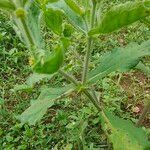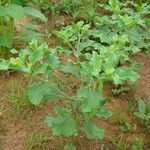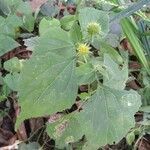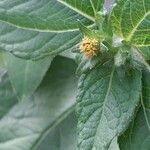Stems erect, 40–60 (–100) cm high. Leaves sessile, ovate to elliptic, 20–125 mm long, 10–45 mm wide, sometimes reduced near inflorescence, usually attenuate at base, shallowly serrate to crenulate, pubescent, pilose on both sides; glands sparse on upper surface, numerous on lower surface. Capitula on peduncle to 25 mm long; outer involucral bracts usually 5, elliptic to ovate, 4–5 mm long; inner bracts longer, usually 7 or 8. Ray florets 5–8, shorter than bracts and disc florets. Disc florets c. 7 or 8. Conceptacles cuneate, compressed, 4–7 mm long, with ribs weak or absent, with straight or slightly hooked prickles on body and 2 divergent spines at apex, densely or sparsely sticky-glandular.
Bushy erect annual herb usually c. 0.3-0.5 m tall, branches leafy. Leaves opposite, oblong or obovate, up to 10 x 4 cm, mostly sessile, margins subentire, repand-dentate or coarsely toothed, both surfaces hispid and gland-dotted. Heads axillary, sessile, 3-5 mm across in flower, up to 18 mm across in fruit. Fertile achenes radiating from the disc, each achene enveloped in an enlarged inner involucral bract forming a wedge-shaped fruit c. 6 mm long, covered in short hooked spines and crowned with 2 long, divergent, curved or straight spines. In fruit from about December to June.
Annual herbs, coarse, erect, to 1.3 m tall. Stems poorly branched, hispid. Leaves sessile or shortly petiolate; blade oblong or obovate, 10-100 × 5-40 mm, both surfaces hispid and gland-dotted, margin subentire and repand-or coarsely dentate. Capitula ± sessile. Achenes compressed and wedge-shaped, narrowing toward base, 5-6 mm with 2 divergent terminal spines 4-5 mm, straight or somewhat hooked; fruit body covered with shorter, hooked spines. Fl. Jun-Jul, fr. Aug-Oct.
A herb. It grows 50-130 cm high. It grows each year from seed. It has many branches and grows each year from seed. It is hairy or thorny. The leaves are opposite and oval. They can have small teeth long the edge. The flowers are small and yellow with spiny bracts. they are clustered in heads. The fruit are flattened and triangle shaped. They are covered in stiff, hooked hairs. There are a pair of spines at the top.
Plants 10–60+ cm. Stems erect. Leaf blades rhombic-ovate to obovate, (20–)40–120(–150+) mm, faces finely pilosulous, gland-dotted. Fruits ± compressed, ± cuneate to obovate, 4–6+ mm, not notably ribbed, terminal spines 2, divergent, 3–4 mm, often 1 ± uncinate, prickles seldom notably uncinate, ± scattered. 2n = 22.
Erect annual herb, 300-500 mm tall. Leaves and stems hispid. Fruit wedge-shaped in outline, somewhat flattened, the 2 terminal prickles the longest. Flowers yellowish.
A bushy annual weed about 12-18 in. high
Achenes 5-10, spreading widely in fruit.
Florets pale greenish-yellow
Small sessile flower-heads




